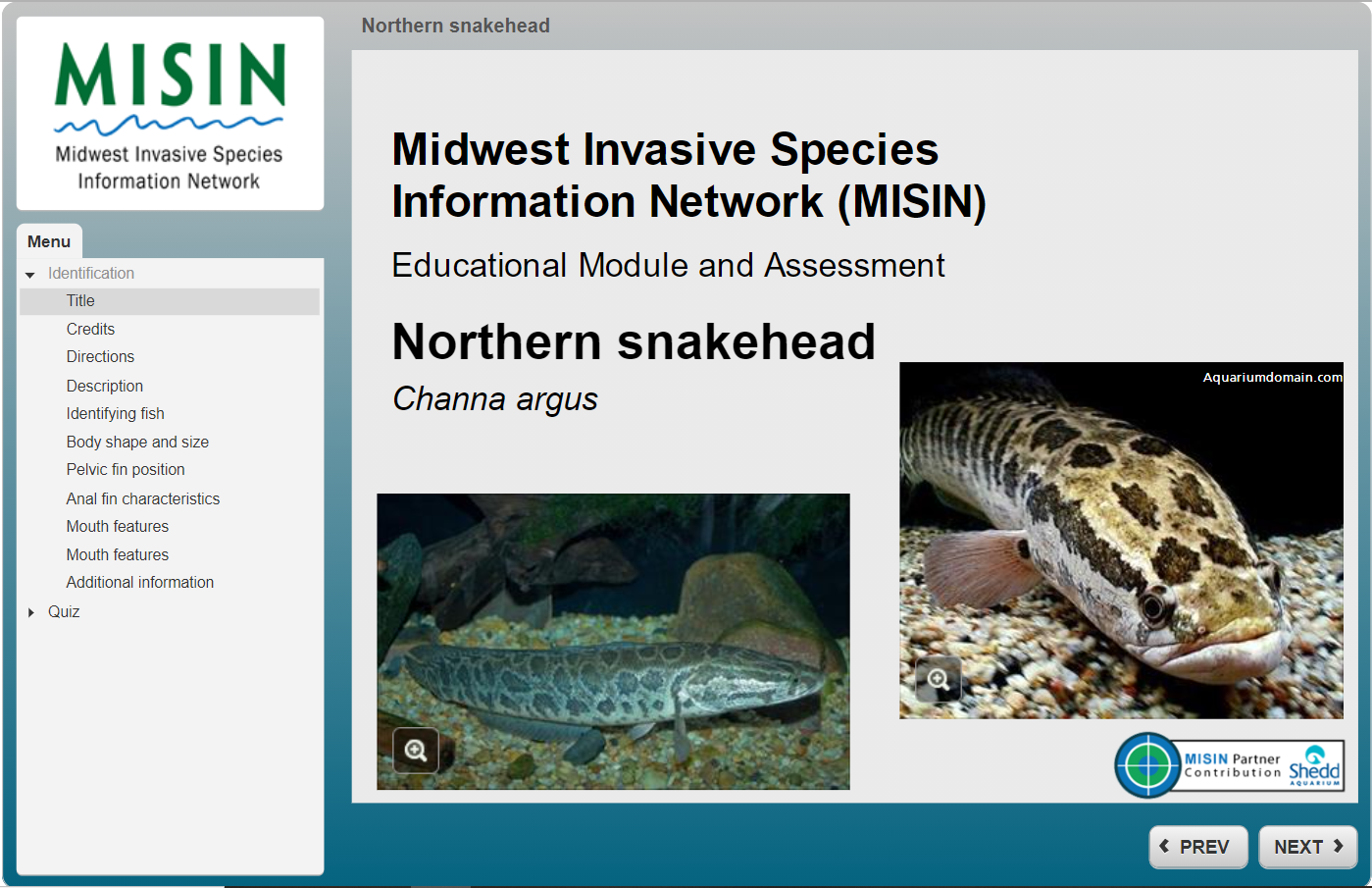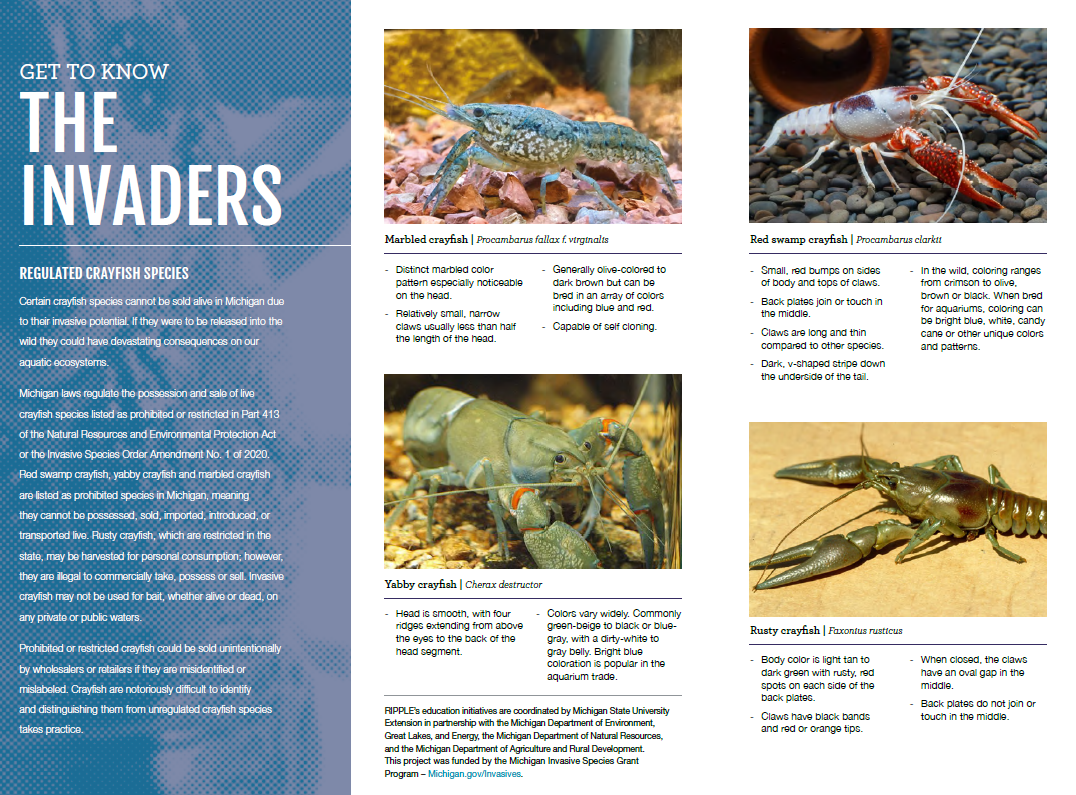Learn to Identify Plants and Animals
Aquarium and water garden are filled with plants, fish, crayfish, snails and much more. Research has shown that sometimes these organisms are accidentally mislabeled by suppliers and shipped to retailers who offer them for sale. Its important for retailers and hobbyists to know about Michigan's regulated species so they can ensure they aren't taking care of an invasive species by accident. Unfortunately plants and animals common in trade can also be difficult to identify.
Identification Assistance
Plant identification is one of the many services offered at the Michigan State University Plant and Pest Diagnostics, Center for Integrated Plant Systems.
Local invasive species specialists with Cooperative Invasive Species Management Areas (CISMA) may also be able to assist in the identification of water garden and aquarium plants and animals. There is a CISMA in every county. Find yours on the Michigan Invasive Species Coalition website. Learn more about CISMAs and the variety of services they offer here.
A Field Guide to Michigan Crayfish published by the DNR highlights native and invasive crayfish in Michigan and includes a user-friendly dichotomous key. Another crayfish resource is the Great Lakes Almanac to Invasive Crayfish which features detailed illustrations of four known invaders: marbled crayfish, red swamp crayfish, Australian crayfish, and rusty crayfish.
The Michigan Clean Water Corps, a volunteer water quality monitoring program, offers trainings on how to detect, monitor, and respond to invasive aquatic plants in lakes. Learn more about the MiCorps Exotic Aquatic Plant Watch here.
RIPPLE Resources
Michigan State University Extension created three identification brochures on aquatic plants, crayfish, and fish species commonly sold for aquariums and water gardens. They are available for free to download or you can receive printed copies through our order form here.
 Learn to identify invasive species online
Learn to identify invasive species online
A variety of resources have been developed to aid in the identification and reporting of invasive species. The Midwest Invasive Species Information Network (MISIN) has a variety of resources including online identification learning modules, interactive invasive species distribution maps, and a webpage for reporting invasive species found in the wild.
MISIN identification training modules take between 10 to 15 minutes to complete and include identifiable characteristics such as the size and shape of a plant or animal, notable physical features and its preferred habitat. Each module ends with a ten question self-assessment quiz. After completing a module you will feel confident enough to identify an invasive species in the wild.
Aquatic Plants
- African oxygen weed (Lagarosiphon major)
- Brazilian Elodea (Egeria densa)
- Carolina Fanwort (Cabomba caroliniana)
- Curly-Leaf Pondweed (Potamogeton crispus)
- Eurasian Watermilfoil (Myriophyllum spicatum)
- European Frog-bit (Hydrocharis morsus-ranae)
- European Water Clover (Marsilea quadrifolia)* On the Michigan invasive species watch list, not prohibited from sale. Handle with care.
- Giant Salvinia (Salvinia molesta, auriculata, biloba, or herzogii)
- Hydrilla (Hydrilla verticillata)
- Parrot Feather (Myriophyllum aquaticum - synonyms: Myriophyllum brasiliensis, Myriophyllum brasiliense, Myriophyllum proserpinacoides and Enydria aquatica).
- Purple Loosestrife (Lythrum salicaria)
- Starry Stonewort (Nitellopsis obtusa)
- Water Chestnut (Trapa natans)
- Water Hyacinth (Eichhornia crassipes)* On the Michigan invasive species watch list, not prohibited from sale. Handle with care.
- Water Lettuce (Pistia stratiotes)* On the Michigan invasive species watch list, not prohibited from sale. Handle with care.
- Water Soldier (Stratiotes aloides)
- Yellow floating heart (Nymphoides peltata)
Crayfish
- Red swamp crayfish (Procambarus clarkii)
- Rusty crayfish (Orconectes rusticus)
Fish
- Bitterling (Rhodeus sericeus)
- Ide (Leuciscus idus)
- Northern Snakehead (Channa argus)
- Rudd (Scardinius erythrophthalmus)
- Stone moroko (Pseudorasbora parva)
- Tench (Tinca tinca)
- Wels catfish (Silurus glanis)




 Print
Print Email
Email